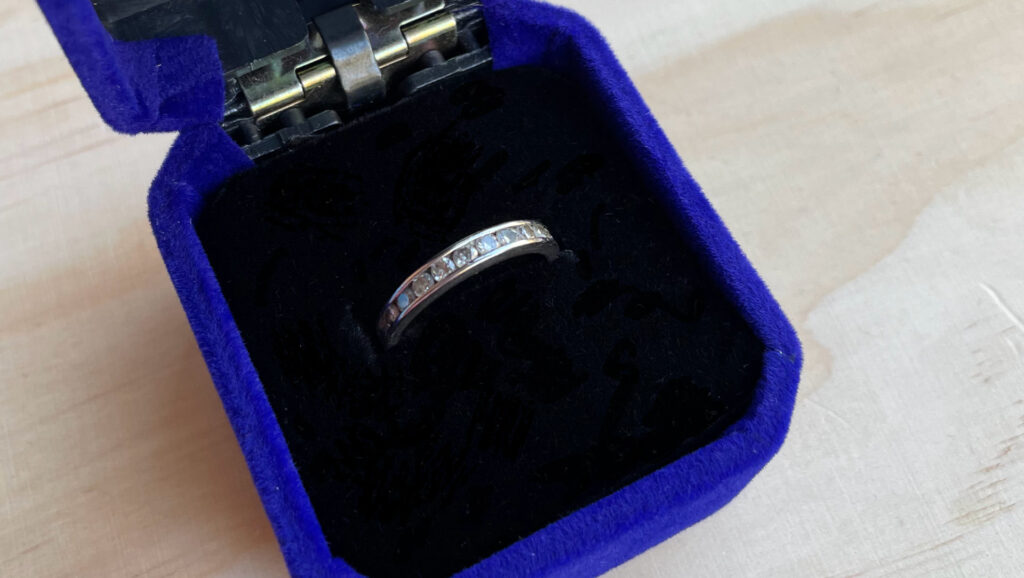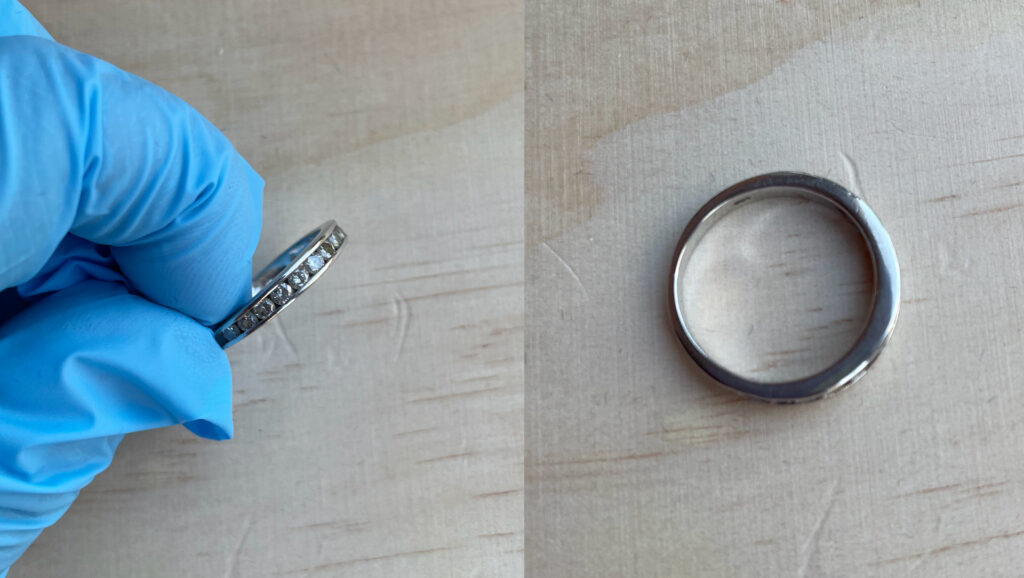This ring is stamped 950 (indicating 95% platinum) and is of unknown age and brand.
In previous decades, cadmium was used for a variety of purposes in fine jewelry and more recently in costume jewelry. It may persist as a trace contaminant in new products.
How do you think this example of platinum tested?

Reading on the Platinum Band:
| Element of Interest | Parts per million (ppm) | Error Range |
|---|---|---|
| Cadmium | 23 | +/- 11 |
| Antimony (Sb)* | 51 | +/- 26 |
| Other Elements | ||
| Chromium (Cr) | 417 | +/- 208 |
| Copper (Cu) | 9,698 | +/- 419 |
| Zinc (Zn) | 1,137 | +/- 78 |
| Bromine (Br)* | 52 | +/- 27 |
| Iron (Fe) | 212 | +/- 100 |
| Zirconium (Zr) | 1,050 | +/- 65 |
| Niobium (Nb) | 1,430 | +/- 84 |
| Indium (In) | 61 | +/- 18 |
| Platinum (Pt) | 298,180 | +/- 14,651 |
| Cobalt (Co) | 9,503 | +/- 423 |
All samples were tested in consumer goods Test All mode using a Niton XL3t 700S for at least 30 seconds. Results are rounded to the nearest whole number. Multiple readings were taken to confirm the results.
Analyst’s Note: When we test items that do not fully fill the 8mm scope of the XRF, total metals will be underreported. For example, a thin platinum ring that is 200,000 parts per million platinum is not necessarily 20% platinum, in a stamped ring platinum will be the highest reading in proportion to other metals found. In the example above, platinum is over 90% of the metals detected. The detected value for cadmium is 23 ppm and cadmium is 0.007% of all metals detected.
When we test a small product like this, our goal is not to identify an absolute parts per million count for all constituent elements, but to screen the product for trace lead and cadmium. In the future, we would like to upgrade the XRF instrument to enable us to better quantify metals found in very small pieces of jewelry, using a 3 mm focused beam.
For those who are curious, neither diamonds nor moissanite stones likely contain lead or other toxic metals. The elements that are comprise these stones are too light for our instrument to detect. Often when we screen these stones with XRF, we only see values for the metal setting in the ring. Lead crystal is different. We will often see very elevated levels of lead when screening rhinestones in costume jewelry.
Test Summary:

Cadmium was detected at levels below specific regulatory standards for cadmium in jewelry.
Although the amount of cadmium detected is only 23 ppm, all metals counts are underreported due to the small size of this ring. We looked at cadmium as a percentage of all metals detected. In this ring, cadmium is 0.007% of all detected metals. This value falls below the .01% limit (100 mg/kg) for cadmium in jewelry sold in the European Union and .03% (300 mg/kg) for children’s jewelry sold in the state of California.
However, it is important to note there is no federal limit on cadmium in adult jewelry sold in the United States. Some examples of costume jewelry sold by unscrupulous manufacturers can be over 90% cadmium, and these toxic products are legal, which is unfortunate.
There can be significant variability in contaminants when testing different types of jewelry. Without strict federal limits on cadmium in jewelry, such as those enacted in the European Union, we cannot recommend any brands of platinum jewelry without testing examples from the brand.
For those who are curious, neither lab created moissanite nor diamonds in fine jewelry are concerning. The elements in these stones are too light for this instrument to reliably detect and do not include lead. Handheld XRF testing on these stones typically detects the metal alloy that the stones are set in and not much else. When we XRF stones we are primarily screening for leaded glass simulants.
We Prefer:
We do not have a recommended platinum product.
If you cannot have your jewelry tested for toxic metals or do not want to wear products with trace cadmium, you might want to choose a metal other than platinum and gold.
Newer sterling silver is usually negative for elements of interest. Cadmium has been used in older solders and and in some other processes refining silver, so we cannot uniformly recommend vintage silver without testing more examples. You may prefer to wear unconventional metal jewelry, like stainless steel if you are not allergic to nickel.
Other Options:
Disclosure: These are Amazon affiliate links. By shopping for any item on Amazon starting with our links, you help support our business and testing.
Note: We do not advise purchasing platinum until we have had an opportunity to test retailers’ current products.
The item we tested above is not on Amazon, so we have added sterling silver bands set with cubic zirconia and other stones below.
Amazon Collection Sterling Silver Diamond Band Ring

Why we like it: This sterling silver ring from Amazon’s brand features conflict-free diamonds.
Micro Pave CZ Band Ring 925 Sterling Silver

Why we like it: This thin stackable sterling band is set with cubic zirconia.
Gem Stone King 925 Sterling Silver White Created Moissanites Stackable Wedding Band

Why we like it: This gorgeous sterling silver ring features lab created moissanite, which is our favorite alternative to diamonds.
Disclaimer: These items have not always been personally tested by us but are likely to be lead free or low lead and/or cadmium based on our research into the materials, discussions with manufacturers, and/or testing on similar products. We recommend items we would use ourselves.
We provide our XRF testing for general educational or informational purposes only to help consumers identify low lead and lead-free products. We hereby disclaim any and all warranties, expressed or implied, and assume no duty or responsibility with respect to how any person or entity chooses to use the information on this website.

